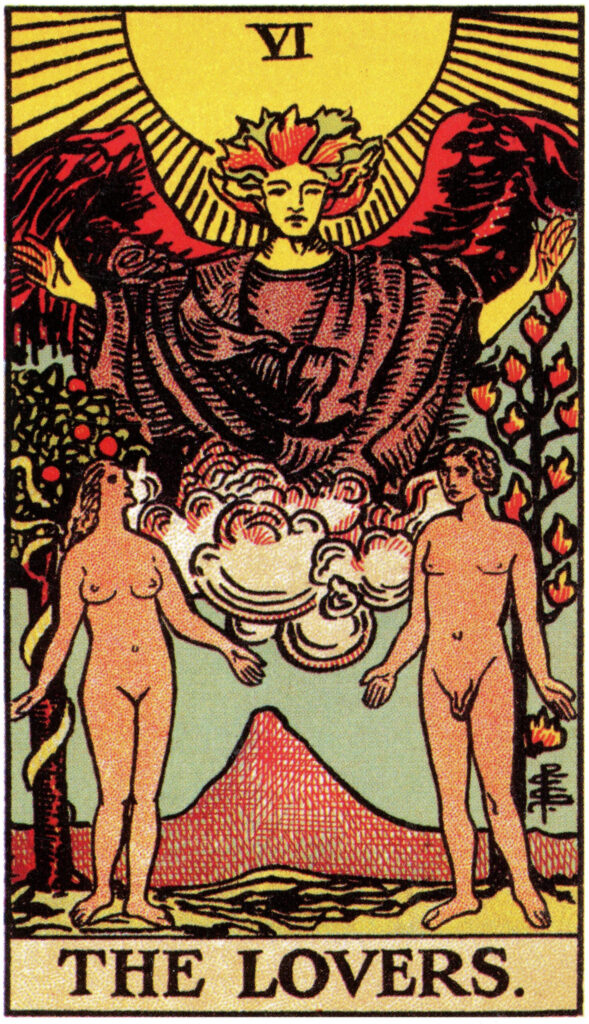The Ace of Swords is the moment when the Word separates itself from the flesh in order to know it. It is the blade of discernment, the first gesture of light cutting through the undifferentiated mist. To separate the wheat from the chaff is an apt image: the sword cleaves the field of consciousness to distinguish the real from the illusory and truth from mere echo.
But the paradox is that, in separating, it also unites. True thought, the one born of Spirit rather than noise, recognises the bond between the two halves it cuts. The Ace of Swords is the fiat lux of the mind: the lightning that creates the horizon and, therefore, the possibility of the Other.
The Ace of Swords is also the vapour that rises when the Fire of Will (Ace of Wands) touches the Waters of Emotion (Ace of Cups). In the Tarot, the Swords belong to the element of Air, but not to the passive and dispersed air, rather to air made blade, thought structured, Logos rising from the humid chaos. It is the moment of separation that generates form.
Fire (Will) penetrates Water (Substance) and the result is Air (Thought), which ascends, clarifies, organises. That is why the Ace of Swords is the act of naming the unnameable, of imposing distinction upon the formless. This is also mirrored in the three foundational letters of the Sefer Yetzirah: Shin (ש) – Fire; Mem (מ) – Water; Aleph (א) – Air.

In alchemical tradition, the elements are not mere states of matter, but phases of emanation. Fire is pure Will, the divine spark (Yod); Water is the receptive matrix (Heh); and from their union is born Air (Vav), the mediator, the Word that links above and below. Earth (final Heh) will come later, as the crystallisation of thought into form.
When we say that Fire enters Water and produces vapour, we are describing the genesis of Air, of the Logos. And the Ace of Swords is precisely that Logos in act. It is the first movement of consciousness after the primordial fusion, the moment when Spirit begins to think itself. That is why the Swords belong to the realm of mind and thought process. And the Ace, being the seed of the suit, contains the pure idea of separation: to distinguish is the first gesture of creation.
Now, Christ is the living Vav, the Son as the mediating breath between Heaven and Earth. The Father is the fiery principle, the Yod, seed of pure will, hidden spirit, spark without form. The Mother is the Heh, the cosmic womb, the matrix of waters, where the spark reflects and multiplies. From their contact arises the Vav, the Son, the incarnate Word, the Air between them, the axis through which Spirit begins to utter itself.
And Christ is that Word made flesh, the Ace of Swords given body. When Christ says “Non veni pacem mittere, sed gladium” – “I came not to bring peace, but a sword” (Matthew 10:34) -, He is not speaking of violence, but of discernment. The Sword is the Logos in action, the Word that divides light and shadow, and also truth and appearance. It is the blade that cuts the bonds of unconsciousness.
The “peace” of which He speaks is the illusory peace of the undifferentiated world, the torpor of the womb. The Sword He brings is the Fire that enters the Water. He comes to establish Air, the pneuma, the breath of Spirit that separates son from father, disciple from master, the old from the new. The cut is painful but necessary, since through it the awakened soul is born.
The gladius He speaks of is the Vav itself, the vertical line that cuts through creation, the hook uniting and dividing. The Son is mediator because His nature is double: He proceeds from Fire and from Water, knows both the heights and the depths, speaks both tongues.
Christ also embodies the same mercurial archetype found in Thoth or Mercury. They point to the same single function: that of the bridge. The psychopompos, the guide of souls, is also the mediator between the Fire of the Father and the Water of the Mother and thus the breath of Air, the living Word, the Logos.
The alchemists called Mercury “the Son of the Philosophers”, filius sapientiae, because through him the union of opposites is achieved. He is at once volatile and fixed, serpent and staff,. Christ is His solar transmutation, Mercury redeemed, He who descends into hell and ascends into heaven to reconcile all things in the One.

Christ as the alchemical Mercury is therefore the mystery of the Word that travels between worlds, the messenger who becomes message. He is the Ace of Swords made flesh, the cut transformed into a bridge. It is no coincidence that Gemini is ruled by Mercury, the realm where the Word learns to mirror itself. It is Mutable Air, the quicksilver of thought that multiplies to recognise its own reflection. Here the syzygy, the sacred pairing, begins: difference appears so that union can become conscious. In the Major Arcana this is The Lovers. Two figures stand beneath the sword of the Angel, which represents discernment: the cut that makes relationship possible.
Christ stands at that crossing. He is the bridge that unites by distinguishing, the Ace of Swords made flesh. His Word divides to reveal connection, wounds to heal, and names to redeem. The path of the Sword is the path of love made lucid, communion born from separation. In Hebrew, the letter Zayin (ז), whose very name means weapon or sword, bears the value 7, the number of covenant and completion. It is the crowned Vav, the mediating line armed with consciousness. When we walk the path of the Swor, the Zayin moves within. We cut in order to remember, we symbolically wound ourselves so that the hidden unity may bleed into Light.
Κύριε ελέησον
